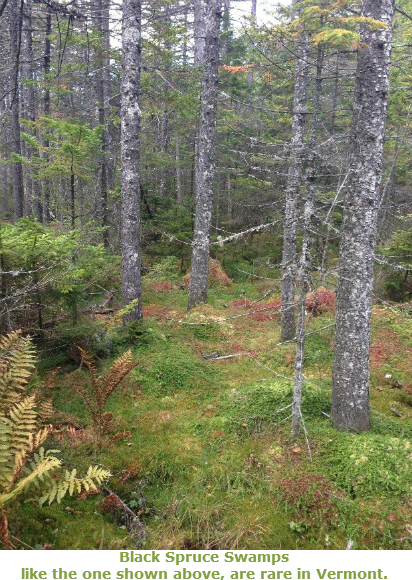 Wetlands that make an important contribution to Vermont’s natural heritage are significant wetlands. These include wetlands that are identified as high quality examples of one of Vermont’s recognized natural community types. There are over forty wetland natural community types recognized in Vermont by the Natural Heritage Inventory, administered through the Wildlife Diversity Program of the Vermont Fish and Wildlife Department. These include rare types such as dwarf shrub bog, rich fen, alpine peatland, and red maple-black gum swamp, and more common types such as deep bulrush marsh, cattail marsh, northern white cedar swamp, spruce-fir-tamarack swamp, and red maple-black ash seepage swamp.
Wetlands that make an important contribution to Vermont’s natural heritage are significant wetlands. These include wetlands that are identified as high quality examples of one of Vermont’s recognized natural community types. There are over forty wetland natural community types recognized in Vermont by the Natural Heritage Inventory, administered through the Wildlife Diversity Program of the Vermont Fish and Wildlife Department. These include rare types such as dwarf shrub bog, rich fen, alpine peatland, and red maple-black gum swamp, and more common types such as deep bulrush marsh, cattail marsh, northern white cedar swamp, spruce-fir-tamarack swamp, and red maple-black ash seepage swamp.
 According to the Vermont Wetland Rules, in determining whether a wetland is significant for the Exemplary Wetland Natural Community function, the Secretary or Panel shall, at a minimum, consider the extent to which it:
According to the Vermont Wetland Rules, in determining whether a wetland is significant for the Exemplary Wetland Natural Community function, the Secretary or Panel shall, at a minimum, consider the extent to which it:
a. Is an example of a wetland natural community type that has been identified and mapped by or meets the ranking and mapping standards of the Nongame and Natural Heritage Program (Wildlife Diversity Program) of the Vermont Fish and Wildlife Department. When evaluating a wetland of a particular natural community type, the rarity of the type is a primary consideration in determining its importance to this function. More generally, larger wetlands in undisturbed condition and in unfragmented landscapes are ranked as the better examples.
b. Contains ecological features that contribute to Vermont’s natural heritage, including deep peat accumulations reflecting thousands of years of history of wetland formation, forested wetlands displaying very old trees and other old growth characteristics, a wetland natural community that is at the edge of the normal range for that type, a wetland mosaic containing examples of several to many wetland community types, or a large wetland complex containing examples of several wetland community types.
Links of Interest
- Vermont Natural Heritage Inventory: The Natural Heritage Inventory, administered by the Vermont Wildlife Diversity Program, documents the diversity of native plants, animals and natural communities in the state. The Natural Heritage Inventory maintains a robust spatial (GIS) database of species and natural community observations used in conservation and regulatory planning.
- Vermont's Rare and Uncommon Native Plants: a list compiled by the Vermont Nongame and Natural Heritage Program intended to inform naturalists, biologists, planners, developers and the general public about our rare native flora, including state Threatened and Endangered species.
- USDA Plant Database: a single source of standardized information about plants including names, checklists, automated tools, identification information, species abstracts, distributional data, wetland indicator status, and other plant information.
- Wetland, Woodland, Wildland: A Guide to the Natural Communities of Vermont. E.H. Thompson and E.R. Sorenson. 2000 and 2005. Published by The Nature Conservancy and Vermont Department of Fish and Wildlife, distributed by University Press of New England.
